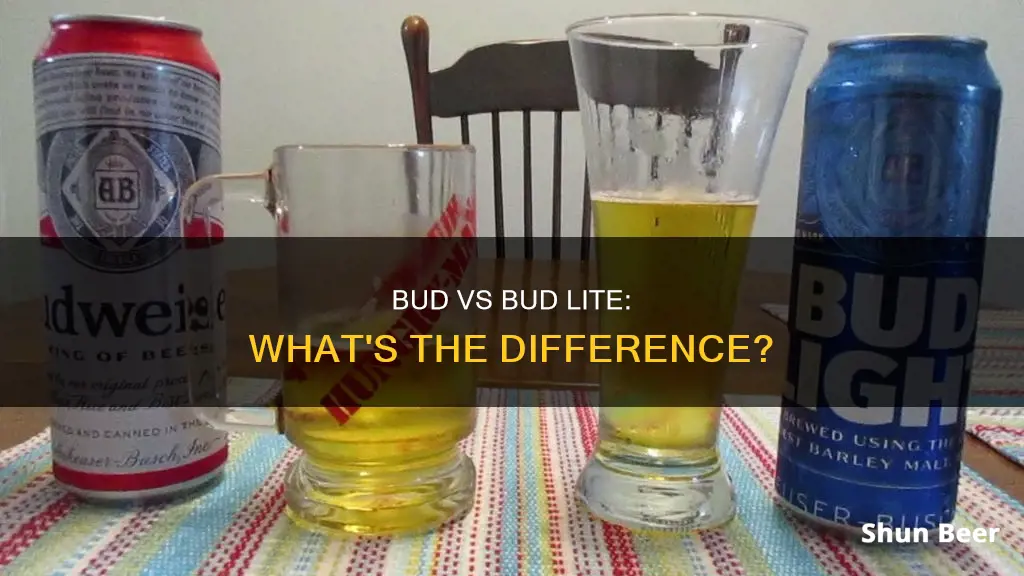
Budweiser and Bud Light are two of the most popular beers in the United States, with Bud Light being the top-selling beer in the country in 2018, shipping 29.4 million barrels. Budweiser, also known as the King of Beers, is a staple on American liquor store shelves and has a light, crisp, and malty taste. Bud Light, on the other hand, is a lighter version of Budweiser with a lower alcohol by volume (ABV) percentage and fewer calories, making it a popular choice for those seeking a healthier option.
Differences between Bud and Bud Lite Beer
| Characteristics | Values |
|---|---|
| ABV | Bud: 5.0% |
| Bud Lite: 4.2% | |
| Calories | Bud: 145 per can |
| Bud Lite: 110 per can | |
| History | Bud: First appeared in 1876 |
| Bud Lite: First appeared in the 1980s | |
| Taste | Bud: Delicate, crisp flavor with malty notes |
| Bud Lite: Clean, crisp, and slightly alcoholic |
What You'll Learn
- History: Budweiser was launched in 1876, Bud Light in the 1980s
- ABV: Budweiser has a higher alcohol percentage at 5.0% compared to Bud Light's 4.2%
- Calories: Budweiser has 145 calories per can, Bud Light has 110
- Marketing: Bud Light has been marketed as a healthier option
- Taste: Budweiser has a delicate, crisp flavour with malty notes, Bud Light is a lighter version

History: Budweiser was launched in 1876, Bud Light in the 1980s
Budweiser has a long and storied history that began in the mid-19th century. Founded by German immigrant Adolphus Busch, who arrived in the United States in 1857, the brand was launched in 1876 as an American-style lager. Busch, who married the daughter of local businessman Eberhard Anheuser, worked in his father-in-law's brewery and helped build Budweiser into an iconic American brand. With its light, malty taste, it became a staple at backyard BBQs and game-day parties across the country.
Anheuser-Busch became the first American brewery to use pasteurisation, allowing Budweiser to be shipped long distances without spoiling. The company also utilised new technologies like artificial refrigeration, refrigerated railcars, and rail-side ice houses, which enabled Budweiser to become the first nationally distributed beer brand in the United States.
During World War II, Budweiser channelled its production into the national war effort, which caused a decline in its market presence. However, after the war, Budweiser regained its popularity and continued to thrive until the 1990s. In 2008, the Belgium beer manufacturer InBev acquired Budweiser's parent company, Anheuser-Busch, infusing new life into the brand with savvy marketing tactics that led to a steady rise in sales.
Building on the success of Budweiser, Anheuser-Busch launched Bud Light in the 1980s. This lighter version of Budweiser was created to appeal to consumers seeking lower alcohol content and fewer calories. With its clean, crisp taste and easy drinkability, Bud Light quickly became a best-selling beer brand in the United States and worldwide. By 2001, it had surpassed Budweiser to become America's best-selling beer.
Both Budweiser and Bud Light are lagers, known for their warm hues ranging from amber to golden brown and their crisp, delicate taste. While Budweiser typically has a higher alcohol content and more calories, Bud Light caters to those looking for a lighter option without compromising on taste. The success of both brands has solidified their place in the highly competitive beer market, with Budweiser's rich history and Bud Light's modern appeal catering to a diverse range of consumers.
The Many Varied Names of Beer Explained
You may want to see also

ABV: Budweiser has a higher alcohol percentage at 5.0% compared to Bud Light's 4.2%
Budweiser and Bud Light are two of the most famous and popular beer brands in the United States, with Bud Light being the top-selling beer in the country in 2018, shipping 29.4 million barrels. Budweiser has a higher alcohol content than Bud Light, with an ABV (alcohol by volume) of 5.0% compared to Bud Light's 4.2%. Budweiser's higher alcohol percentage is reflected in its higher calorie count of 145 calories per can, while Bud Light contains 110 calories per can. Budweiser's ABV of 5.0% is slightly higher than other beers in its category, contributing to its reputation as a staple on American liquor store shelves. Bud Light's ABV of 4.2% is on par with other mild beers like Coors Light, Michelob Ultra, Miller Lite, Busch Light, and Corona.
The difference in alcohol content between Budweiser and Bud Light can be attributed to the variations in their recipes. Both beers share similar ingredients, including water, malted barley, rice, yeast, and hops. However, the ratio of these ingredients differs, resulting in Bud Light being a lighter version of Budweiser. The lower ABV and calorie count in Bud Light have been strategically marketed as a healthier option, appealing to health-conscious consumers.
The history of these beers also plays a role in their distinct characteristics. Budweiser was first introduced to the market in 1876 by German immigrant Adolphus Busch and has since become an iconic American beer. Bud Light, on the other hand, was launched in the 1980s during a financial boom for the Budweiser parent company, Anheuser-Busch. The creation of Bud Light was a strategic move to tap into the growing demand for low-calorie beers, solidifying its position as a dominant player in the market.
In conclusion, while both beers share similar ingredients and are considered lagers, the key difference lies in their alcohol content. Budweiser's higher ABV of 5.0% caters to those seeking a slightly stronger beer, while Bud Light's milder 4.2% ABV and lower calorie count make it a preferred choice for those looking for a lighter, healthier option. Ultimately, the choice between Budweiser and Bud Light comes down to personal preference, as both beers offer distinct experiences within the lager category.
Belgian Beers vs. Sour Beers: What's the Difference?
You may want to see also

Calories: Budweiser has 145 calories per can, Bud Light has 110
Calories are an important consideration when choosing a beer, especially if you're watching your weight or want to avoid a beer belly. Budweiser and Bud Light have notably different calorie counts, which could influence your decision when choosing between the two.
Budweiser has 145 calories per 12-ounce can. This calorie count is relatively high compared to other popular beers, which typically range from around 95 to just under 150 calories. Budweiser's higher calorie content is due in part to its slightly higher alcohol percentage of 5.0% ABV, as well as its ingredients, which include rice, malted barley, yeast, hops, and water.
On the other hand, Bud Light contains 110 calories per can, which is significantly fewer than Budweiser. This lower calorie count is a result of Bud Light's reduced alcohol content, with an ABV of only 4.2%. Additionally, while sharing many of the same ingredients as Budweiser, the ratios are adjusted to create a lighter version.
The difference in calories between Budweiser and Bud Light can be a deciding factor for health-conscious consumers. With 35 fewer calories, Bud Light may be more appealing to those looking for a "healthier" option without sacrificing taste. However, it's important to note that "healthier" doesn't necessarily mean "healthy," as even light beers can contribute to weight gain and other health issues when consumed in excess.
Ultimately, the choice between Budweiser and Bud Light comes down to personal preference. Both beers have their unique characteristics, and while Bud Light may be slightly lower in calories, Budweiser offers a fuller flavour and a more substantial alcohol content.
Learn to Order Beer in Many Languages
You may want to see also

Marketing: Bud Light has been marketed as a healthier option
Bud Light has been marketed as a healthier option when compared to Budweiser and other similar beers. With an alcohol content of 4.2% and 110 calories per can, it has fewer calories and a lower alcohol by volume (ABV) percentage than Budweiser. This positioning of Bud Light as a healthier alternative has been a successful strategy, with the brand dominating the US beer market and achieving high sales.
The marketing of Bud Light as a healthier option aligns with consumer preferences for lower-calorie and milder alcoholic beverages. This strategy taps into the growing consumer awareness of health and wellness, allowing individuals to make more informed choices about their alcohol consumption. By offering a "lighter" version of Budweiser, the company caters to those who are conscious of their calorie intake without compromising their enjoyment of beer.
The branding and advertising of Bud Light contribute to its perception as a healthier choice. The name "Bud Light" itself conveys a sense of reduced intensity or a lighter version of the original Budweiser. The packaging and promotional materials may also use colours and designs that evoke a sense of freshness, lightness, and health. Additionally, the company has likely conducted extensive market research to identify the right messaging and visuals to reinforce the idea of Bud Light being a better option for health-conscious consumers.
The success of Bud Light as a healthier alternative can also be attributed to its ability to meet consumer preferences for flavour and taste. While some low-calorie or light beers may compromise on flavour, Bud Light has managed to strike a balance. It offers a similar taste profile to Budweiser, albeit with a slightly lighter or milder flavour, as suggested by its name. This allows consumers to feel like they are making a healthier choice without sacrificing the sensory experience and pleasure associated with drinking beer.
Furthermore, the positioning of Bud Light as a healthier option has likely contributed to its broad appeal and market penetration. By catering to health-conscious consumers, the brand has attracted a wider range of drinkers, including those who may be watching their weight or aiming to moderate their alcohol intake. This strategy has helped Bud Light establish itself as a popular choice not only for special occasions or indulgences but also for everyday consumption, further contributing to its market dominance.
In conclusion, the marketing of Bud Light as a healthier option has been a pivotal aspect of its success and popularity. Through strategic branding, advertising, and product development, Bud Light has tapped into consumer preferences for lower-calorie and milder alcoholic beverages while still offering an enjoyable drinking experience. This positioning has allowed the brand to resonate with health-conscious consumers and establish itself as a leading choice in the highly competitive US beer market.
Beer vs Spirits: Understanding Alcoholic Beverage Differences
You may want to see also

Taste: Budweiser has a delicate, crisp flavour with malty notes, Bud Light is a lighter version
Budweiser has a delicate, crisp flavour with malty notes. Its golden hue and iconic cans are instantly recognisable to beer drinkers across the United States. Budweiser's ingredients include rice, malted barley, yeast, hops, and water. The result is a beer with 145 calories per can and a 5.0% ABV. Its flavour is described as a little malty, a little sweet, and a bit heavier than expected.
Bud Light, on the other hand, is a lighter version of Budweiser. It has a lower alcohol content (4.2% ABV) and fewer calories (110 per can). The ratio of ingredients is slightly different, resulting in a lighter-tasting beer. Bud Light is clean and crisp, making it ideal for hot-weather consumption. It has been described as tasting like a slightly alcoholic cream soda. It is also said to have a typical taste of cheap grain and stale paper.
The Anatomy of a Beer Cask: Understanding Its Parts
You may want to see also
Frequently asked questions
Budweiser has 145 calories per can, while Bud Light contains 110 calories per can.
Budweiser has an ABV of 5.0%, while Bud Light has an ABV of 4.2%.
Both beers are made from water, malted barley, rice, yeast, and hops, but the ratio of ingredients differs, with Bud Light being a lighter version of Budweiser.
Budweiser was first launched in 1876 by German immigrant Adolphus Busch. Bud Light was introduced much later in the 1980s.
Budweiser has a delicate, crisp flavor with malty notes. Bud Light has been described as clean, crisp, and ideal for hot-weather consumption, tasting like a slightly alcoholic cream soda.







